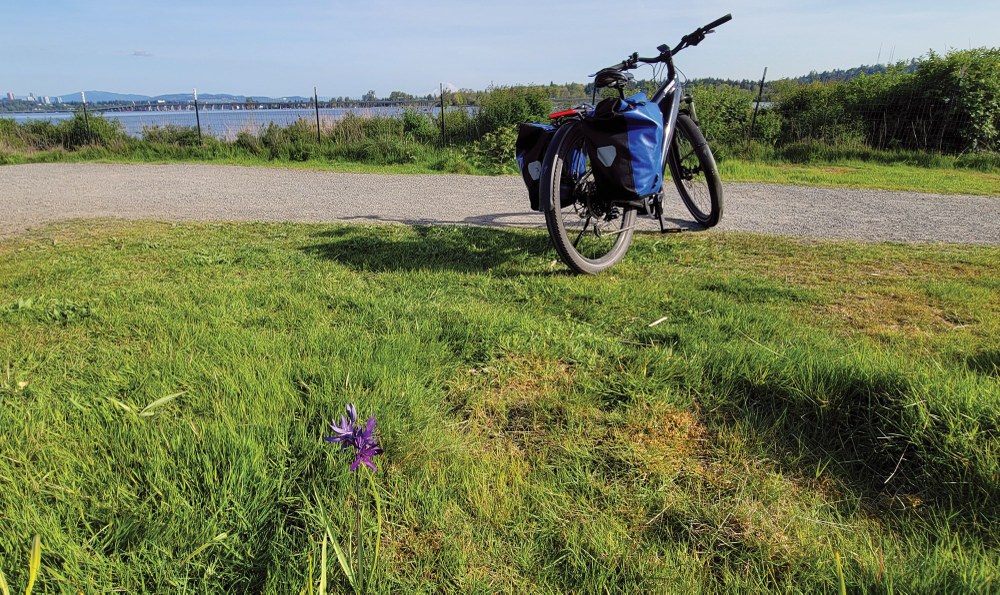
“Those who contemplate the beauty of the earth find reserves of strength that will endure as long as life lasts. There is something infinitely healing in the repeated refrains of nature - the assurance that dawn comes after night, and spring after winter.”
- Rachel Carson, The Sense of Wonder
I take nearly the same route on my bike commute every day. I know the road, its gradient, and contours. I know where potholes, speed bumps, and stop signs require focused attention, and thus where I can shift my curiosity to nearby nature… to the sky, the shoreline, the forest floor, and surrounding vegetation.
Riding the same road, again and again, also leads to new experiences. I find reverence for the natural world each day, through shifting light and seasons. Without a windshield, I can tune my senses to my surroundings. My separateness from nature becomes an illusion. I feel more connected.
Beyond the benefits of health, efficient travel times, and free parking, my carbon-cutting bike commute offers the gifts of familiarity: familiar flora and fauna, fragrances, and daily surprises. The landscape becomes a constant companion in my travels. It's part of the adventure. It’s a source of wonder.
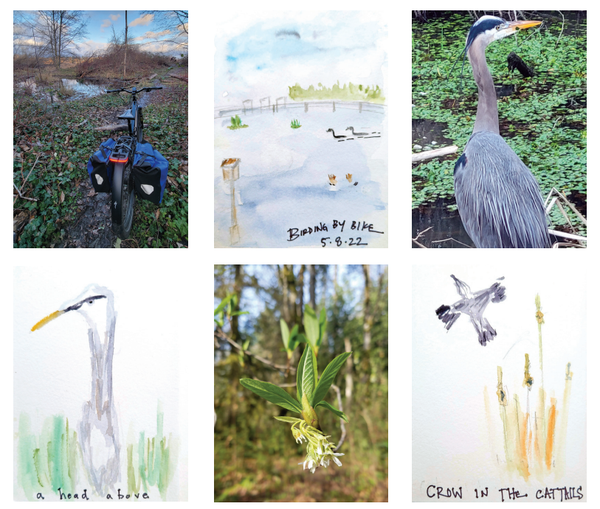 Photos clockwise from top left: Leaving the bike to walk toward surprises. A heron at the lake's edge. Indian plum, the harbinger of spring.
Photos clockwise from top left: Leaving the bike to walk toward surprises. A heron at the lake's edge. Indian plum, the harbinger of spring.
The seasons cycle, too
Phenology, a word stemming from the Greek “to show and to bring light to,” is the study of cyclical events often observed by the ecological markers that showcase shifting biological phenomena, such as budding flowers in spring or yellow leaves in fall. As a year-round bike commuter, my rides feel like an extension of this seasonal phenology.
It’s easy to notice the cycling of seasons from the saddle. Look around. Take notes. What birds, cloud patterns, or garden flowers do you see? How does speed or slowness bring these gifts to your eyes?
Whether or not you track the weather, you’ll notice that humidity records its relativity on our faces, sometimes with a fine mist. Temperature tells our toes to twitch to warm up, or to relax along the ride. On my daily commute, I’m under the weather. Wind, rain, sun… I’m part of it all.
From my saddle, I’ve learned that what you choose to notice shapes your moment. Be curious, whatever your environment.
Experiencing the natural world doesn’t only happen far away or in places accessed by car. Instead, nature is right here, right where you are. You can ride right along with it – all you have to do is look at what's just beyond your wheels.
Sure, some rides are for getting somewhere fast. But others are for rambling. Don’t be afraid to slow down. Paying attention is usually worth the pause.
Summer: Savoring sun and shade
Summer is short. Savor every moment. In fact, the act of savoring might be a secret to greater happiness and mindfulness.
Imagine the peach you pull from your panniers, the roadside blackberries that burst in your mouth and stain your fingertips, the sundrenched bench where you rest your wheels as you take a dip in the lake after a long ride.
The foliage of deciduous trees is full. Watch the dappled light along the path. Shadows grow and shrink and paint patterns throughout the day. A pair of perched bald eagles laughs above.
Some say the art of adventure is to get home before dark. Others might savor a sunset and the twinkle of a few stars before rolling home. I’ve been known to linger late beyond magic hour, so much so that I’ll frequently stay out overnight on bikepacking or bike camping adventures. I let my summer branch beyond the beaten path.
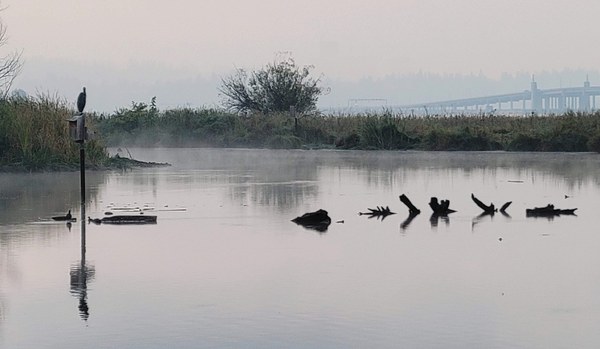 Smoky skies at Lake Washington, fall.
Smoky skies at Lake Washington, fall.
Autumn: Falling and flying
Autumn is a season where much is falling – falling leaves, falling temperatures, falling back into school routines. As an educator, my regular routines return and I watch what falls around me: bigleaf maples and deeply veined horse chestnut leaves. Ochre and sienna blanket the path, crunch under my pedals, and clog storm drains.
Like the season, my commute falls too. Set on seven hills carved by glacial retreat, Seattle’s topography undulates like a wave, and any cyclist knows that pedaling involves some ups and downs…
The first section of my commute is a stand-in-my-pedals, gravity-gliding goodness that feels like falling, or rather, flying. Ca-caw, I shout with the corvids, seeing the world through their eyes and listening to them in song and swoosh. Riding without earbuds helps heighten this interaction. I’ll soar, and sometimes even flap my arms (a "look ma, no hands" trick in solidarity with the flock).
My commute hugs the shoreline of Lake Washington. Leaving my bike at a notable gravel edge, I dip a glass jar each fall through the small, green dots of duckweed that coalesce on the water. The world is full of life when you look, even below the surface. The scale of my wonder slides in and out, from big and small: the view of Mount Tahoma, the sunrise over the peaks, a little jar with a screw top lid in my damp, chilly hands.
My students and I will admire the microscopic magic later: daphnia and rotifers swimming in just a drop. Later in the season, I’ll return to this spot to linger at last light, each day a little less.
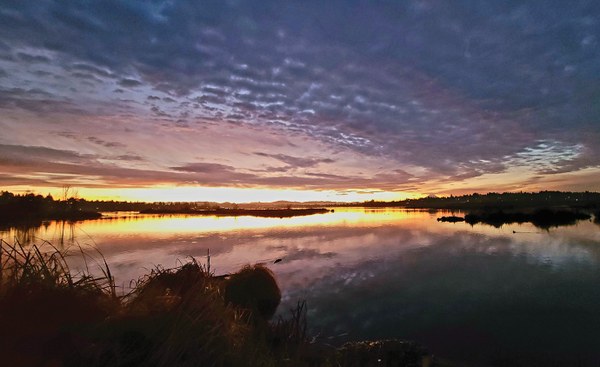 Sunrise at Lake Washington, winter.
Sunrise at Lake Washington, winter.
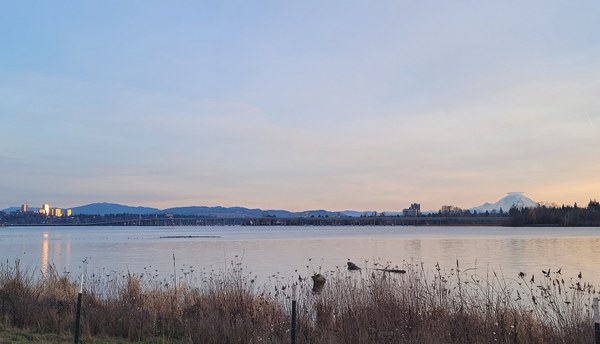 Afternoon light at Lake Washington, winter.
Afternoon light at Lake Washington, winter.
Winter: Rain and frost
It’s dark. The morning is dark, and the afternoon bike home is darn near dark, too. But the dark sky is filled with the magic of stars, aligned planets, and a snow moon reminding me that I never have to scrape ice.
Just being outside lifts my mood, making me feel grounded and connected. Under streetlights, the white tail of a rabbit darts across the street. Once or twice, I've seen a coyote trot across my path, its bushy, gray tail hanging low with the fog. Many winter mornings, rain speckles my glasses, making kaleidoscopes of tail and traffic lights, or creating a pattering rhythm on my helmet. This is the sound of the season. Splash, thwap. Ping. Pitter, patter. Plop. Chuckle. Giggle. You’ve heard the saying: There’s no bad weather, only bad gear.
Once this winter, I was startled by a flat tail on the lumbering body of some beast beside the small channel. It took me a minute to register this beaver out of water as he cruised the gravel in the middle of the path. By the time I put my foot down to dig my camera out of my bag, he had entered the water without a splash. When I stepped closer, weaving between tanned and twisted cat tails, he smacked his tail and flushed a flock of surf scoots, black wings wiggling away. I missed the photograph, but will never miss the distraction of having devices on my handlebars.
A Civil Cycle
It's well below freezing
as I'm leaving my house
at civil twilight by bike
bundled beyond belief.
It's two degrees below
zero C,
the sun is six degrees
below the horizon,
see sky barely blushing.
I have a little
extra time before school
and I take the long way.
The gravel path is frozen
solid and the edge
of the lake is still
with cracked ice.
A beautiful, belted kingfisher
spies me before I pedal beneath
as it chatters away.
Then, just around the corner,
breathtaking, the mountain
spy-hops out of the lake,
sun pops over the peaks
cascading warm light onto all this fabulous frost.
The cattails, the snowberry,
the grass, the bench that steals
my heat as I bend for a quick
sit and a longer look at all this awe.
My toes are numb
but my heart is full.
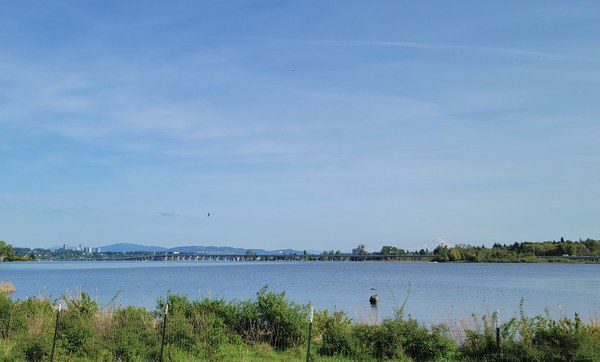 Sunny skies at Lake Washington, spring.
Sunny skies at Lake Washington, spring.
Spring: Pedaling by petals
According to UW meteorologist Cliff Mass, Seattle has the longest spring season of any city in the country, with the most days between 50 to 70 degrees Fahrenheit. As we hurtle out of the big dark toward the vernal equinox, the amount of change in these months is rapid and redolent. In the light, we can see more colors. Pay attention to the nuances – the subtleties of a color’s shade and hue, as well as the textures.
First, fixate on the greens. A fan of paint chips doesn't do justice to the range of greens present in the Emerald City. While rhododendrons, cedar, and salal remain richly evergreen all winter, horsetail — now emerging from a roadside ditch — reaches out of the winter duff like a paintbrush loaded with sap green and striped with chartreuse. At nearly eye level, look for the harbinger of spring: Indian plum. First a rosette, then skyward, oval-shaped lime leaves before pendant white flowers speckle the urban woods. Through twigs and damp, squelchy spots below the paths, the neon spadix and hood of the skunk cabbage’s spathe announce spring in both color and aroma. Welcome back friends, it’s nice to see you.
I pedal by petals and watch witch hazel show off well before spring, with yellow or red slender straps, like little strips of flagging tape. Then, the saracocoa and daphne scent the air with a jasmine-like perfume that stops me cold. Catkins, a cylindrical cluster of petalless flowers, dangle and drip from birch and alder, depositing pollen to the wind. The winged seed samaras of bigleaf maple trees twist and tumble down. Red flowering currants and neighborhood camellias remind me of my grandmother’s lipstick. Cherry blossoms burst around the corner. In a few weeks’ time, the pavement will look like it’s covered in pink snow. Magnolia petals, thick and pale pink like my puffy coat, do the same and brown beneath my tires.
Seasons and cycles: Back around again
Summer returns with early morning sunrises and late sunsets. Our days expand. We are full, and have come full circle, back around to savor cycles from the saddle.
The route is familiar, and yet somehow new. There is an idiom that says you can’t step twice in the same river. This is especially true if you adopt a naturalist's perspective. Lean over the handlebars, and look. See how cycling attunes your senses.
Paying attention to nearby nature is a skill for any season. And whatever the season, you make the road by riding. By riding, you notice; by noticing, you wonder; by wondering, you learn; and by learning, you participate in the shared language and knowledge of nature’s community.
As you ride, what will you notice this time? How might you note these moments of wonder on our pale blue dot, spinning another cycle around the sun?
This article originally appeared in our summer 2025 issue of Mountaineer magazine. To view the original article in magazine form and read more stories from our publication, visit our magazine archive.
 Jessica C Levine
Jessica C Levine